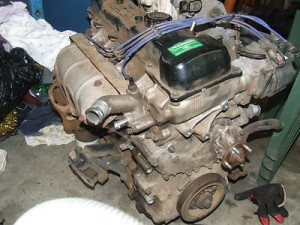
2RZ-E and 2RZ-FE engines
 The 2-liter four-cylinder 2.4RZ engine began to be installed on Toyota HIACE WAGON cars in August 1989. When developing power units of the RZ series with serial numbers 1 and 2, a single technical platform was used. The increase in power in 2RZ engines was achieved by increasing the volume of the combustion chambers and the use of larger diameter pistons.
The 2-liter four-cylinder 2.4RZ engine began to be installed on Toyota HIACE WAGON cars in August 1989. When developing power units of the RZ series with serial numbers 1 and 2, a single technical platform was used. The increase in power in 2RZ engines was achieved by increasing the volume of the combustion chambers and the use of larger diameter pistons.
In 1995, the 2RZ engine was modified to use a new twin-shaft cylinder head, resulting in the 16-valve 2RZ-FE ICE. The use of this arrangement made it possible to achieve a significant increase in the power and traction characteristics of the motor.
The coding of the 2RZ-E and 2RZ-FE engines contains almost complete information about the design features and type of power units:
- “2” is the serial number of the engine within one series;
- “R” is the general designation of the series, which determines the type of engines: in-line four-cylinder internal combustion engine with a timing chain drive;
- "Z" - a sign of a gasoline engine;
- "E" - a sign of the internal combustion engine power system: electronic multi-point injection;
- “F” is a sign of the number of valves and the layout of the camshafts in the cylinder head: 4 valves per cylinder, the standard “narrow” layout with a chain drive per camshaft.
Technical specifications
| Parameter | Value | |
|---|---|---|
| Manufacturer | Toyota Motor Corporation | |
| ICE model | 2RZ-E, petrol | 2RZ-FE, petrol |
| Years of issue | 1989-2005 | 1995-2004 |
| Configuration and number of cylinders | Inline four-cylinder (I4/L4) | |
| Working volume, cm3 | 2438 | |
| Bore / Stroke, mm | 95,0/86,0 | |
| Compression ratio | 8,8 | 9,5 |
| Number of valves per cylinder | 2 (1 inlet and 1 outlet) | 4 (2 inlet and 2 outlet) |
| Gas distribution mechanism | Chain, with the top arrangement of a shaft (SOHC) | Chain, with the top arrangement of two shaft (DOHC) |
| Cylinder firing sequence | 1-3-4-2 | |
| Max. power, hp / rpm | 120 / 4800 | 142 / 5000 |
| Max. torque, N m / rpm | 198 / 2600 | 215 / 4000 |
| Supply system | Distributed Electronic Fuel Injection (EFI) | |
| Ignition system | Distributor (distributor) | |
| Lubrication system | Combined | |
| Cooling system | Liquid | |
| Recommended octane number of gasoline | Unleaded gasoline AI-92 or AI-93 | |
| Type of transmission aggregated with internal combustion engine | 5-st. manual transmission and 4-speed. automatic transmission | |
| Material BC / cylinder head | Cast Iron/ Aluminum | |
| Engine resource by mileage (approximate), thousand km | 350-400 | |
Applicability on cars
The 2RZ-E engine was used on the following Toyota car models:
- HIACE WAGON 08.1989/08.1995-08.1995/07.2003 and XNUMX/XNUMX-XNUMX/XNUMX;
- HIACE ROYAL 08.1995-07.2003;
- HIACE COMMUTER 08.1998-07.2003.
The 2RZ-FE engine was used on Toyota vehicles destined for the European and North American markets:
- HILUX 08.1997-08.2001 (Europe);
- TACOMA 01.1995-09.2004 (USA)
Features of operation and maintenance
In Russia, 2RZ-E and 2RZ-FE engines are quite rare, so it is difficult to find any significant reviews on them. At home, in Japan, these engines also did not become widespread, despite some gain in power compared to the first samples of the series under the serial numbers 1RZ. Most likely, this is due to the increased level of vibration in the 2RZ motors, associated with the design features of the inline four. In the third sample of the series on 2.7-liter engines, this drawback was eliminated by using a complex balancing mechanism in the head of the BC, and in the ICE with a volume of 2.4 liters, Toyota designers did not provide for such compensation.
Since the 2RZ and 1RZ engines are structurally very close and were developed almost simultaneously, their characteristic features basically coincide. The advantages of 2RZ engines, like those of 1RZ, include fuel efficiency, reliability, ease of operation and maintenance, and a long service life. The disadvantages, in addition to the increased level of vibrations, are the criticality of these engines to the quality and condition of the engine oil and the risk of damage to valves and pistons when the circuit is broken.
The failure of the development and the dead end of the further development of the 2RZ engine family is also evidenced by the fact that the engines of the RZ series with a volume of 2.0 liters (1RZ) and 2.7 liters (3RZ) were replaced by engines of the new TR series, similar in design, supplemented by modern devices and devices, but this did not happen with the 2.4 l line.

